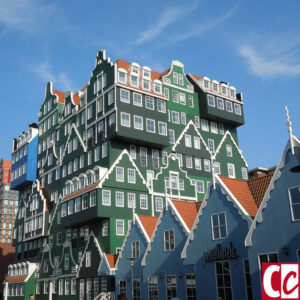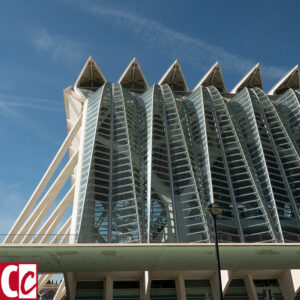
Architecture has become more interesting since the 1970s than it was before. The New Objectivity movement was sleek and practical, but it ran the risk of becoming boring. A much-needed change was brought about by postmodern building.
The term postmodern architecture (1970s-present) is confusing in my opinion, as is the name modern or modernist architecture (1890s-1970s). Modern means contemporary while by now the modernist architecture movement is almost obsolete.
After all, what should the next movement be called, post-postmodern? But since this is the term everyone uses, I comply. 🙂
Some of the links are affiliate links. As an affiliate associate, I earn a small commission when you purchase any of the products offered through the shared links at no extra cost to you. This helps me to maintain this website and I thank you for supporting me.
Table of Contents
Postmodern architecture
Postmodern architecture is a reaction against the rigidity of modernist architecture through the reintroduction of classical elements and old architectural styles.
Knowledge starts with being curious

In the past, I was more interested in visual arts than architecture. The architecture in my area was not very interesting and entire residential areas were demolished without a preconceived plan for reconstruction.
My attitude changed when we had the opportunity to hire an architect ourselves for a major conversion from a garage to an office.
We had conversations with inspired and inspiring architects and delved into what we considered beautiful enough to want for our own building.
Response to modernist architecture
An important characteristic of postmodern architecture is its use of free forms, imaginative details, and historical references. Postmodernists attach great importance to continuity, so they explicitly link up with past architectural styles.
Modernist Ludwig Mies van der Rohe introduced the statement “Less is more”. Postmodernist Robert Venturi rephrased this as “Less is a bore”.
Because the big picture matters, architects and designers such as Graves, Starck and Mendini also create furniture and household items.
Related: Spectacular Buildings and Modern Art in Bilbao, Spain
Urban development and cohesion
Big plans do not always come to fruition due to a lack of money and opposition. When Calatrava was asked to design the Liège station while also giving the surrounding area an uplift, there was a lot of enthusiasm.

Ultimately, this urban planning was only partially realized.
Inntel hotel, Zaandam
A striking example of focusing on the environment is the Inntel hotel. This building is part of the city centre redevelopment of Zaandam with more buildings in this style.
Zaandam has many traditional houses of green painted wood. The different colours of green are even named Zaans Green after the city.
Frank Gehry
In 2022 we travelled a lot as a reaction to the lockdowns and being restricted to the house for 2 years. And coincidently we saw several of Frank Gehry‘s buildings.

- LUMA, Arles, France;
- Pavillon de Musique, Chateau La Coste, Le Puy-Sainte-Réparade, France;
- Guggenheim Museum, Bilbao, Spain.
My admiration grew exponentially when I saw a documentary in which he explained his ideas. Such enthusiasm and thoughtfulness.
If he explains how he immerses himself in the environment where a building will be located and how historical events inspire him, this is clearly visible in the end result.
It also becomes apparent what the differences are between, for example, LUMA in Arles and Guggenheim in Bilbao, even though shiny metal has been used as the facade cladding in both buildings.
Other buildings he has designed and that are now on my bucket list to visit are:
- Vitra Design Museum, Weil am Rhein, Germany;
- Dancing House, Prague, Czech Republic;
- Experience Music Project, Seattle, USA.
Related: Museum LUMA in Arles, a Lively Creative Breeding Ground
Santiago Calatrava
Calatrava is a controversial architect. His buildings are beautiful, but often the construction budgets are hugely exceeded and construction errors quickly occur.
Unfortunately, modern buildings often suffer from this. That is the disadvantage of using new materials.
It was no different in the past. Towers slumped because the foundations weren’t strong enough, think Leaning Tower of Pisa, or buildings didn’t withstand the storms and collapsed.
It’s a luxury to just enjoy the beauty of the new architecture. We don’t have to worry about budget overruns, although construction errors can be a problem for us.
Ciutat de les Arts i les Ciències
It is not often that an architect is given the opportunity to design an entire area. Calatrava got that chance when Valencia wanted to turn the area of the drained Turia River in the city centre into an icon.
The project includes 6 buildings, a city garden, a bridge, and a metro station. Most notable are the mosaic stones, which even line the subway vents.
Seeing Bilbao’s success in attracting tourists with the Guggenheim museum, Valencia aimed to achieve the same success. This was accomplished.
Renzo Piano

When we visited Santander to admire the pictures of PHotoEspaña we stumbled upon the Centro Botín to our surprise.
A similar building in Amsterdam, the new wing of the Stedelijk Museum, was immediately given the nickname “De Badkuip” (Bathtub). I have not been able to discover whether Spaniards are so quick with name-calling as well, although the building lends itself perfectly to a nickname.
We knew Renzo Piano from the Center Pompidou in Paris, but Centro Botin has an entirely different character due to the convex, dense forms.
In contrast, the water-facing space, formed by both wings, is delicate and airy.
Martin Creed
Usually, we take the stairs instead of the elevator or escalator, but because we had walked around the city for quite some time to visit the PHotoEspaña locations, we did take the elevator this time.
Good thing, too. I wouldn’t have wanted to miss Martin Creed’s sound installation. Have a look at my video and enjoy. 🙂
Interesting architecture
Even though I am an admirer of “Less is more”, I am glad contemporary architecture has evolved into something really interesting.
Not all designs are equally successful, but they are often subject to controversy. It sparks discussions and makes people wonder why they consider something to be beautiful or ugly.
Some more well-known postmodernist buildings
- Groninger Museum, the Netherlands, by Alessandro Mendini;
- Bonnefanten Museum, Maastricht, the Netherlands by Aldo Rossi;
- Sydney opera house by Jørn Utzon.
What do you consider the most beautiful postmodern building? Tell me in the comment box below.













